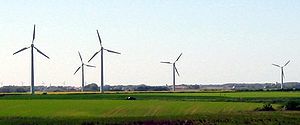 Image via Wikipedia
Image via Wikipedia
Potential independent power producer (IPP) developers for South Africa’s first 3 725 MW of renewable-energy capacity are working to finalise their bids after the Depart- ment of Energy (DoE) released the long-awaited request for qualification and proposals documentation on August 3.
The stakes are high given that, collectively, the projects are likely to involve investment of more than R100-billion across the technologies outlined in the tender.
For government, too, it is vital to begin responding practically to the country’s electricity deficits because the roll-out has become core to its objective of generating jobs, indus- trial development and growth around the renewables build programme.
Indeed, both the New Growth Path and the Industrial Policy Action Plan have placed so-called green industries at the centre of South Africa plans to grow employment and to stimulate manufacturing investments and activities.
Government, which will host the big climate negotiations in Durban at the end of the year, is also keen to use the process to showcase South Africa’s response and to provide a practical outlet for the funds its wants directed to developing- country adaptation and mitigation plans.
It has emerged that government is engaging with a range of international funders to partner with South Africa in implementing its large-scale renewables programmes. Such funding will be used to offset any possible further spike in the electricity price path that could otherwise arise from the large-scale adoption of renewables. It could also help safeguard investments at the scale required to attract manufacturers of renew- ables technologies and components.
Technology Allocations
The DoE has allocated capacity across various renewables technologies, with 1 850 MW set aside for onshore wind, 200 MW for concentrating solar thermal, a further 1 450 MW for solar photovoltaic solutions, 12.5 MW for both biomass and biogas, 25 MW for landfill gas capacity, 75 MW for small hydro, and a further 100 MW for small-scale IPP projects of less than 5 MW.
The DoE has allocated capacity across various renewables technologies, with 1 850 MW set aside for onshore wind, 200 MW for concentrating solar thermal, a further 1 450 MW for solar photovoltaic solutions, 12.5 MW for both biomass and biogas, 25 MW for landfill gas capacity, 75 MW for small hydro, and a further 100 MW for small-scale IPP projects of less than 5 MW.
Some developers have immediately indicated that the enlargement of the procurement capa- city beyond the 1 025 MW set out for the first procurement round in the Integrated Resource Plan (IRP) 2010–2030 is a welcome development.
However, questions were also asked both about the credibility of the IRP as a guideline for new generation capacity, and whether the 3 725 MW framework is indeed of sufficient scale to encourage investment by green-energy original-equipment manufacturers (OEMs).
Nevertheless, potential participants are grateful that the process, which was initially expected to start in April, is finally under way, albeit that their favoured procurement model is not being deployed.
The renewables industry has indicated that it would have preferred the request for proposals (RFP) to have been premised on predetermined renewable-energy feed-in tariffs (Refits). But government has abandoned Refit in favour of a selection process that would involve both price and nonprice elements, having raised concerns about its legal compatibility with government procurement rules, as well as the fact that such schemes have in other countries led to prices that could now not be sustained.
June 14 Deadline
The RFP shows that projects will only be considered if they can feasibly enter commercial operation by June 2014. However, concen- trating solar thermal projects will qualify if they are able to show that commercial operations can be achieved by June 2015.
The RFP shows that projects will only be considered if they can feasibly enter commercial operation by June 2014. However, concen- trating solar thermal projects will qualify if they are able to show that commercial operations can be achieved by June 2015.
Besides meeting these timelines, projects would also need to pass land security, environmental, grid connectivity, primary-energy availability, technical feasibility, generation forecasting, legal, black economic-empowerment, economic-development, as well as regulatory thresholds.
For instance, wind developers would need to provide 12 months of wind data from the proposed site, as well as an independently verified generation forecast, and show that the proposed contractors have participated in at least two previous projects. The projects would also only qualify if they were larger than 1 MW and smaller than 140 MW in size and included turbines that are IEC 64-100 certified.
Similar criteria have been set for the solar projects but greater emphasis is given to water use and availability. Fuel supply agreements, meanwhile, are central to the biomass and bio- gas projects, while possible developers of landfill gas sites would also need to be in possession of a public–private partnership agreement with the relevant municipality, in accordance with Section 120 of the Municipal Finance Management Act. The small hydro bids would, meanwhile, require an independent review of the hydrology information, as well as at least ten years of flow data.
The documentation also indicated that four criteria would be used to make a financial evaluation of the project, including price, financial standing, robustness and delivery of the funding proposal, and robustness of the financial models.
Bidders would be required to provide their pro- posed prices per megawatt hour for the energy output to be generated, through the applicable technology, along with full or partial inflation indexation. The price indication would be for the first 20 years of operation, or for the duration of the power purchase agreement (PPA).
The IPPs will be authorised to enter into a PPA with Eskom, as the buyer, once the DoE has selected them.
Pushing for Development Spin-Offs
But, besides the pricing, financial, legal and technical criteria, the IPPs would also need to show how their projects could stimulate job creation, local content and local manufacturing, rural development and community involvement, education and development of skills, enterprise development, socioeconomic development and participation by historically disadvantaged citizens.
But, besides the pricing, financial, legal and technical criteria, the IPPs would also need to show how their projects could stimulate job creation, local content and local manufacturing, rural development and community involvement, education and development of skills, enterprise development, socioeconomic development and participation by historically disadvantaged citizens.
Overall, the economic development aspects will comprise 30 points in the eventual evaluation process, with job creation and localisation carrying the biggest weighting of 25% each.
DoE deputy director-general Ompi Aphane tells Engineering News that the upscaled procurement programme has been pursued to make the programme more attractive to those OEMs considering localisation options.
A mandatory bidders briefing session has been scheduled for September 14, at 10:00.













